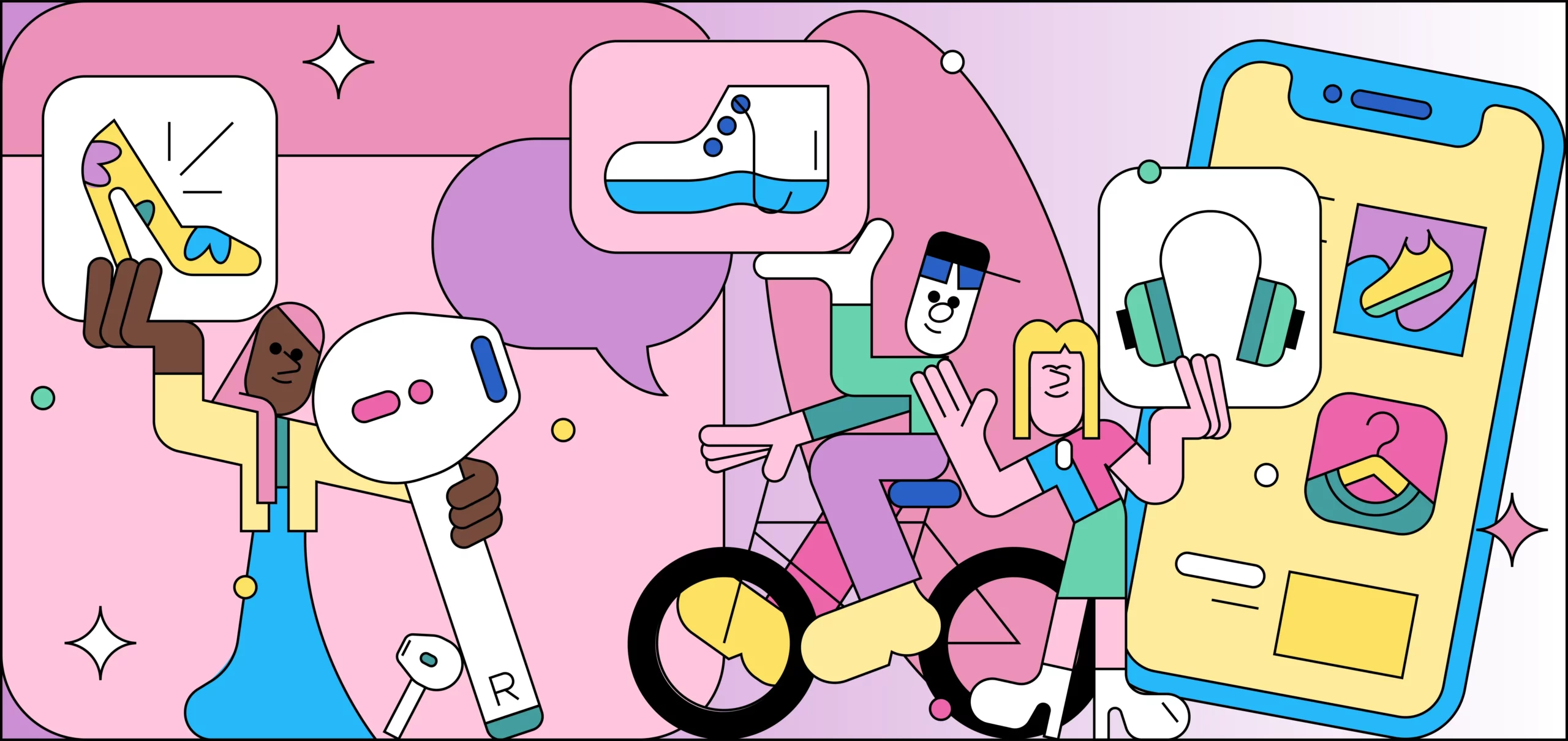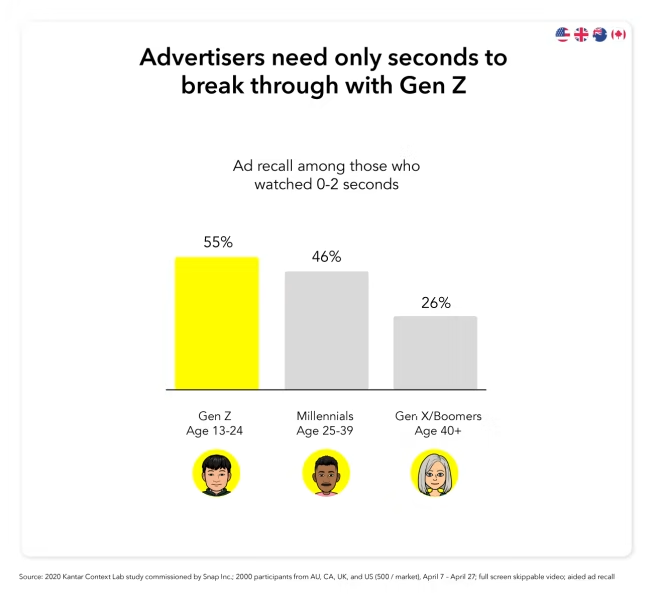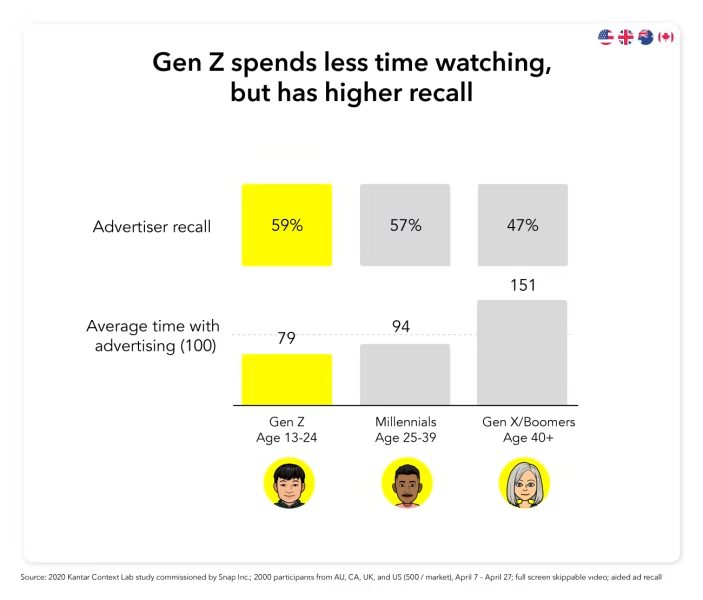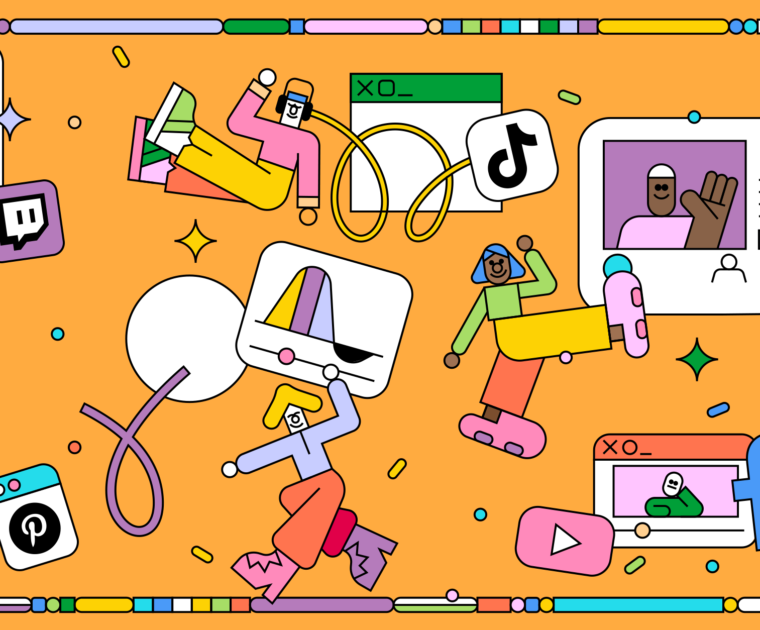Gen Z consumers have some pretty unique characteristics, especially as it relates to how they spend their time, what they value and how brands should reach them. Gen Z is a financial powerhouse, and half the members of this generation haven’t even entered the job market yet.
But smart marketers have their sights set on converting them now. To date, Generation Z is the single most influential generation of kids in history to wield sway over Mom’s and Dad’s wallets. And their financial superpowers are only going to get stronger.
Who Is Generation Z?
Generation Z is the age group born between approximately 1996 and 2012, though there continues to be some debate around the exact birth years that make up Generation Z. In general, the consensus says that the members of the cohort that follows Millennials were born starting in the mid-1990s up through the early 2010s.
Gen Z commands a remarkable $360 billion in buying power according to Bloomberg, compared to $143 billion in buying power just 4 years ago. For the next 20 years, as this generation continues to enter the workforce and maximize their earning potential, their spending power will continue to increase.
Which is why we’re even talking, right?
Today, while some of them still have to be in the house before the streetlights come on (jk – kids today have no idea about the street-light curfew their parents grew up with), Gen Zers play a huge role in how the adults around them spend money.
Ninety-three percent of parents say their Gen Z children influence their household spending. Another 70 percent of parents ask their Gen Z kids for advice before making purchase decisions. That’s A LOT of influence.
The obvious next question you probably have is how can you influence them to buy your product or service?! Let’s find out what makes post-millennials buy.
While the oldest members of Generation Z have already entered the workforce and are starting families, its youngest members are still in middle school.
8 Gen Z Spending Habits to Inform Your Marketing Strategy
#1 Gen Z Consumers Value Their Boundaries and Their Privacy
Generation Z consumers don’t play about their privacy. They take extra measures to safeguard their personal information. As this article’s being updated, Snapchat users – 58 percent of whom are between the ages of 13 and 24 years old (or about 364 million people) are flooding social conversations with negative reviews of Snapchat’s new AI feature, using words like “invasive” and “creepy” to describe the AI’s ability to always know (and share) where users happen to be. And it’s a new feature they cannot opt out of without subscribing to Snapchat’s premium monthly subscription.
So the headlines are all like…
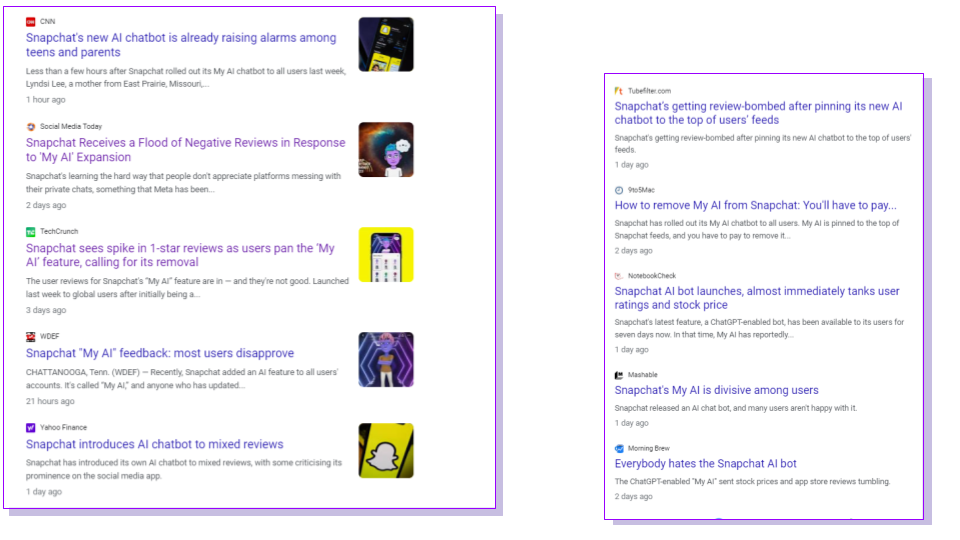
Boundaries matter to Gen Z! and Snapchat seems to have wandered into a privacy landmine that’s ticking off large portions of its users. Take a look at the following stats from SheerID:
- 87 percent of Gen Zers say privacy is more important than getting “likes” on social media.
- 75 percent of them will only use location features on apps when it’s required to function (which is why Snapchat users are going ham).
- 58 percent turn location sharing on and off based on how and when they wish to use it.
- 33 percent of Gen Zers worry about the security measures of brands.
- 38 percent worry that brands are sharing their personal info without consent.
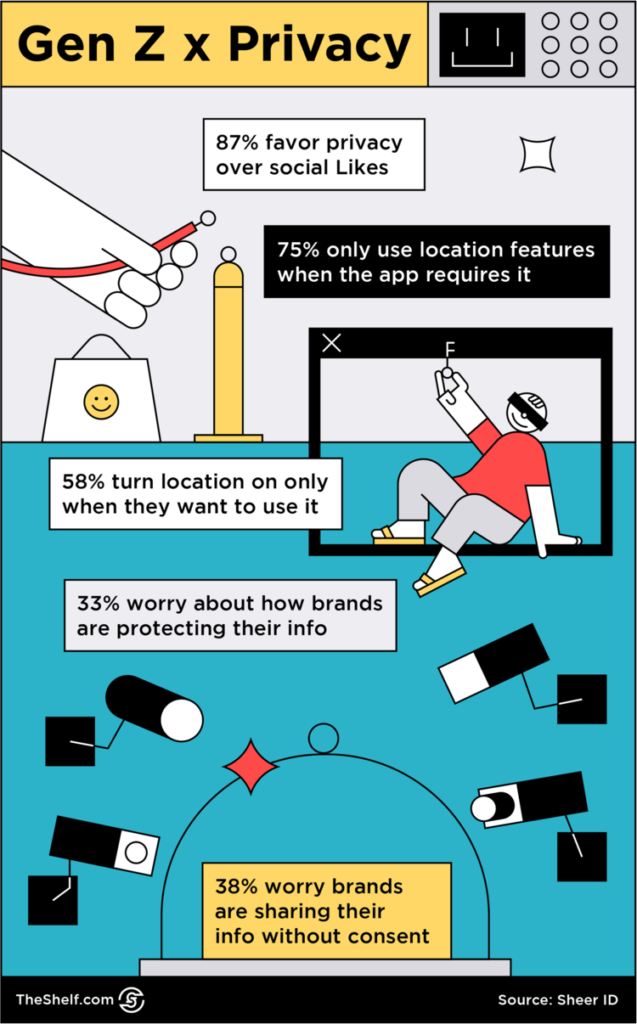
COPY AND PASTE THIS CODE TO EMBED ON YOUR SITE
It’s also worth noting that fewer than 1 in 3 teens are cool with the idea of sharing their personal details beyond just contact info and purchase history.
Now, don’t go crazy. I’m not saying you can’t try collecting their emails to market to them. Two in three Gen Zers are okay sharing their personal information with brands they trust.
So, build some trust!
Create useful content that’s targeted. Personalization is big with these guys. The key is to prove your value then assure them you’re taking the proper measures to protect their data.
Value + security. That’s your way in.
#2 Gen Z is Willingly Loyal to Brands (assuming your brand offers the best overall deals)
Loyal to brands? In 2023? Yah. With post-millennials, you have a pretty good chance of snagging loyal customers — but only if you can align with their expectations (and slim personal budgets).
Gen Zers are looking at your brand’s mission, product quality, and service before committing. So, you’re going to need to fine-tune these areas if you want their ongoing business.
- 60 percent of Gen Z consumers are happy to be associated with their brand of choice.
- 2 in 3 say they’ll stick with the brands they like and buy from them for years.
- 65 percent admit that rewards programs influence which brands they choose.
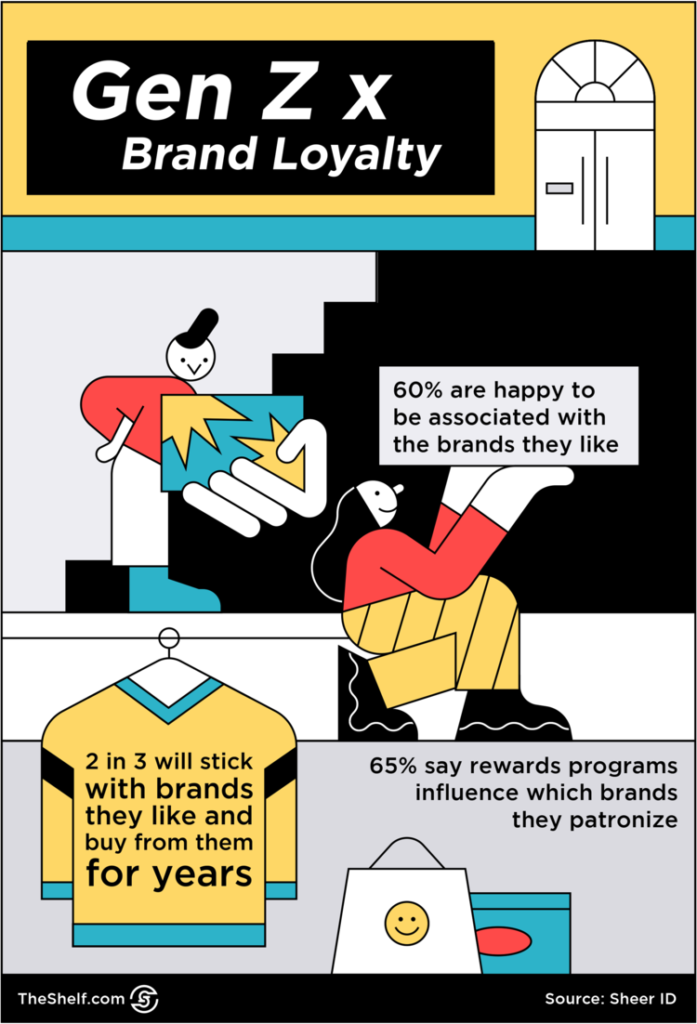
COPY AND PASTE THIS CODE TO EMBED ON YOUR SITE
For Gen Zers, if you can demonstrate your loyalty to them and align with their values and needs, then they’ll return the favor by becoming a long-term customer. Which brings us to the next point – personalization.
#3 Personalization Is Super Valuable for Building Trust
Young consumers are looking for personalized experiences from brands. They want to know you’re listening and that you see them. Things like rewards programs matter and they have a HUGE impact on whether younger buyers patronize your brand. Plain and simple.
Rewards programs
We talked about rewards programs a bit in the post on millennial dads, and like millennial dads, Gen Zers aren’t super-thrilled about having to track down promo codes. So, you’ll probably find that a rewards program that sends or notifies them of specific rewards works best.
So, we’re not really talking about creating a bunch of digital coupons that Gen Zers will have to go on a treasure hunt to find. That won’t really work. Restaurants like Wendy’s, Chick-Fil-A and Chili’s send emails and/or SMS notifications to their customers of deals and FREEBIES (like free desserts, sandwiches, and BOGO deals) straight to their phones. Super smart, since Gen Zers tend to over index on eating out and being more adventurous when it comes to food as compared to other generations, according to Morning Consult.
Other apps have geo-fencing capabilities that remind users of existing deals whenever they are within close proximity of the store.
So, whether you want to offer free chicken sandwiches or a birthday discount if you don’t have a rewards program yet, it’s time to create one. And keep in mind that price is critical to these savvy shoppers — 60 percent of Gen Z base their brand choice on price. Yeah, they influence a significant amount of household spending, for most of them, Mom and Dad are still supplying them with spending money in the form of an allowance.
Targeting with gated content
Also, consider developing a plan to attract them with gated content. Capitalize on this by creating exclusive promotions for different groups based on their ages, affiliations, or occupations.
For example, you can have separate promotions for college students, recent grads, and adults in the workforce. Aligning your content and your offer to their individual needs will show you understand them and are committed to helping them.
Not sure if it’ll work? Maybe this will make you feel better:
- 41 percent of Gen Zers say gated content makes them feel rewarded
- 41 percent say they feel special
- 54 percent feel excited
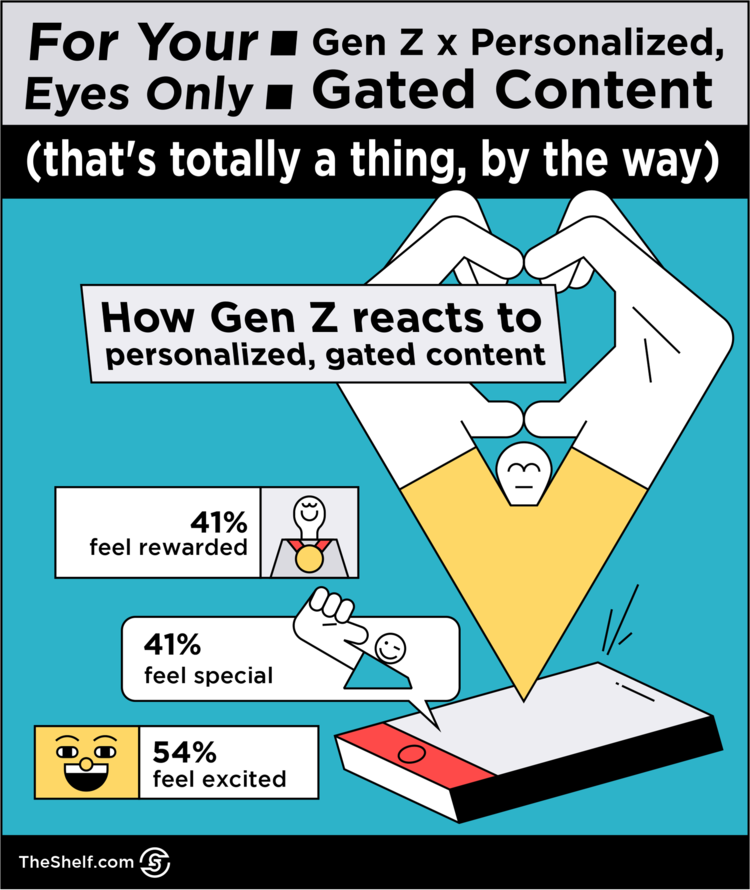
COPY AND PASTE THIS CODE TO EMBED ON YOUR SITE
Identity marketing
A fancy term that just means you’re personalizing your marketing for different groups based on their life stages, affiliations, occupations, passions, etc. This is a great solve for the zero-party-data world we’re living in, folks. And it works with younger consumers because this form of personalization provides an opportunity for Gen Z consumers AND their peers to take advantage of your promos, rewards, discounts, and special access opps.
Think of how important a student discount may be to a college student in the current environment. According to a webinar I attended just today sponsored by SheerID, 89 percent of students would buy more if extended a student discount. And the retailers who offer these types of discounts typically see a 20 percent increase in average order value.
Add to that this stat (from the same webinar) that 72 percent of high school and college students polled said they would be more loyal to brands that gave them exclusive offers.
Short-term discount for long-term loyalty.
#4 Gen Zers Are Working Earlier and More Than Millennials Did At the Same Age
For Generation Z, money is a HUGE motivator. When it comes to things that matter to Gen Z, 62 percent of those polled say that success matters to them. More than any other generation, they would say that challenging themselves, upskilling and making progress are high on their list of important values.
Twenty-something Gen Zers are shopping for homes already. And let me tell you — they’re not doing the tiny house thing. They want 2,000+ sq ft and are willing to buy a fixer-upper at a lower price to get it.
Gen Z members are also working while in school, which was one of the things millennials didn’t really do as much as previous generations.
Whereas millennials wanted to focus solely on their education and then enter the workforce after college, Gen Zers are already working. About 10 percent of them are working full time, earning $229B in FT employment wages, according to Influencer Marketing Hub. They’re not trying to follow in the footsteps of the 13 percent of millennials who didn’t even have jobs until after they were in their twenties.
Here’s another interesting tidbit: Nearly half of Gen Zers (46 percent) have already joined the gig economy to maximize their earning potential and get the things they want.
For Gen Z consumers, your hustle matters.
What are they buying? Well, they’re buying what young people buy. Clothing is at the top of their shopping list, no doubt driven by the desire to sport different looks in the photos they publish to Instagram and other platforms. But it’s worth noting that they’re willing to pay for a monthly membership to access lightly used clothes (and even clothing repair services).
Makes sense, right? Gen Z did grow up during a recession.
So what does all of this mean for marketers?
I mean… Gen Z is a budget-conscious group that likes to earn and spend money. That’s all teens and young people, isn’t it?
Yeah, but we’re talking about recession kids. This group has a different mindset. They can save enough cash for a down payment on a home within five years. A home.
If you can offer something they really want, they’ll find a way to make the money to buy it. The thing is, you have to know how to make your thing attractive to this generation. If you do that, even if your price is steep, they’ll find a way to increase income so they can buy it.
A quick tip: If you can come up with payment plans and other methods to maken buying your thing more affordable without sacrificing quality, you’ll significantly boost your chances of winning them over.
#5 Gen Z Cares About What Your Brand Cares About
It’s not enough to develop a product or service that’s within their budget. And it’s not enough to have the best-quality offer to meet their needs.
If they learn that your brand is all about making money or, worse, participating in egregious acts (like hiring kids in a sweatshop), then you can forget about earning their trust and loyalty.
In fact, you may even get your brand name slandered all across social media. So it’s time to straighten up and find a cause if you haven’t already.
Social responsibility matters to younger buyers. So, let me ask you: what do you stand for? And how does your brand reflect that you’re concerned about what matters to them? The time has come to look deep and ask yourself what cause you can back passionately and effectively, because when Gen Zers are looking at your products, you better believe they’ll be looking for your answer.
If you need some guidance around social issues that really move this generation, take a look at what they care about most. You can compare them to millennials below.
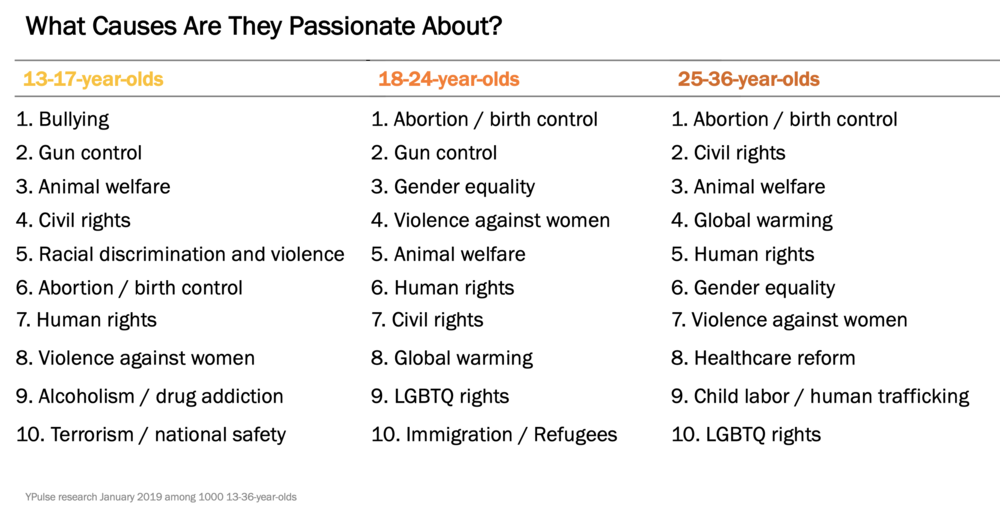
#6 For Generation Z, Connection Comes From Authenticity
Geez… who isn’t on the hunt for authenticity these days? Between your typical brand hyperbole, social media filters, AI, and magic-working makeup, it’s hard to find “real” anywhere.
For the 12 to 27 crowd, there are a handful of things that are really critical when it comes to engaging with brands. Because young people talk. They are quick to share their experiences – positive or negative – with their communities. And these communities rely on recommendations from others within the community.
According to SmartBrief, “Some 27 percent of Gen Z consumers always share recommendations or reviews following purchases, while 37 percent do so most of the time.”
Almost 69 percent ‘very often’ search for reviews and recommendations of items they’re considering buying, per an infographic from Social Media Link.
More than 85 percent of Gen Z consumers trust recommendations from friends and family the most, followed by online reviews at just over 76 percent and social followers at 62 percent.
What to do when the authenticity you need to demonstrate is off-brand
You want to reach younger consumers, but your brand team is giving you the side eye about your campaign ideas. Well, this mini-article is going to provide tips for some workarounds for brand guidelines that make it difficult to seem relevant.
If you want to reach younger buyers, the fastest path to their attention is to integrate technology and creative storytelling into your marketing strategy. And visual marketing works really well for this.
GRAPHICS AND IMAGES
If your brand is using photoshopped images and staged props, you’re less likely to convert a Gen Z scroller into a clicker. Something like 79 percent of post-millennials say they’ll trust a brand more if it doesn’t use photo editing.
If you’re getting resistance from higher-ups on your loosening the restrictions around your branding and marketing assets, say so. Tell your audience the story of how you can’t take shortcuts and then document your process and release that content as behind-the-scenes footage. Heck, you could even create a meme.
Twenty-nine percent of Gen Zers who answered a Meta poll said BTS content makes them feel a closer connection to brands. Boom! Just what you needed to see, right? Here’s another one: 57 percent like it when brands participate in memes, according to the 2022 YouTube Trends Report.
Focus on your internal process and the humans behind the beautiful photoshoots and product layouts. This way you boost awareness around your product AND connect with the audience. It’s a smart workaround to stay on your CMO’s good side and still win authenticity points with younger buyers.
MESSAGING
This is another sticky area where brands – especially legacy brands – have a hard time jumping into the fray to appeal to younger buyers. If your messaging is typically more formal or high-brow, it’s going to be tough to suddenly switch things up and start using slang and making dance-trend videos. Without seeming like the Pierce of the group (“Community” reference).
The fix? Influencers, dude. This is the situation in which influencers are worth their weight in GOLD! Creators have a knack for creatively delivering brand messaging in language that resonates with THEIR audiences (not yours).
If your team has done a great job with influencer selection, the audience of your influencer partner WILL ALSO BE a segment of your target audience.
Influencers are perfect for this sort of thing because they can demonstrate the value of your product contextually, in a way that matters to your audience. I LOVE this example from skateboarding TikToker GmCasto for CeraVe (the way he keeps saying “might as well” tho.)
@gmcasto CeraVe lotion is so good for my skin that I had to try it out for skating @CeraVe #ceravepartner #cerave ♬ original sound – Garrett Casto
Look at the comments! This piece of #sponcon art right here 👆🏽 is why working with non-celeb influencers works so well. And if you can create an edgy campaign, then even better.
Gen Z doesn’t love traditional marketing… and they’re really good at not noticing it.
VIDEO
Teens watch twice as many videos on mobile than any other group. As a brand, YouTube has more influence over this generation than big names like Oreo, Mcdonald’s, and even Lego.
Eight-five percent of teens watch YouTube, and 70 percent of them watch two hours of YouTube daily, usually in one of three categories:
- Humor – They love videos that make them laugh
- Short and snappy content to compete with their busy lives and busy minds
- Unboxing and product reviews to keep on top of trends
Now that I think of it, I can grab a screenshot of something from an internal insights hub our team built on Notion for Generation Z. It’s not the most beautiful thing we’ve ever published, but it’ll give you an idea of the preferred content formats for Gen Z. And let’s give it up for Notion templates!! 👏🏽👏🏽👏🏽
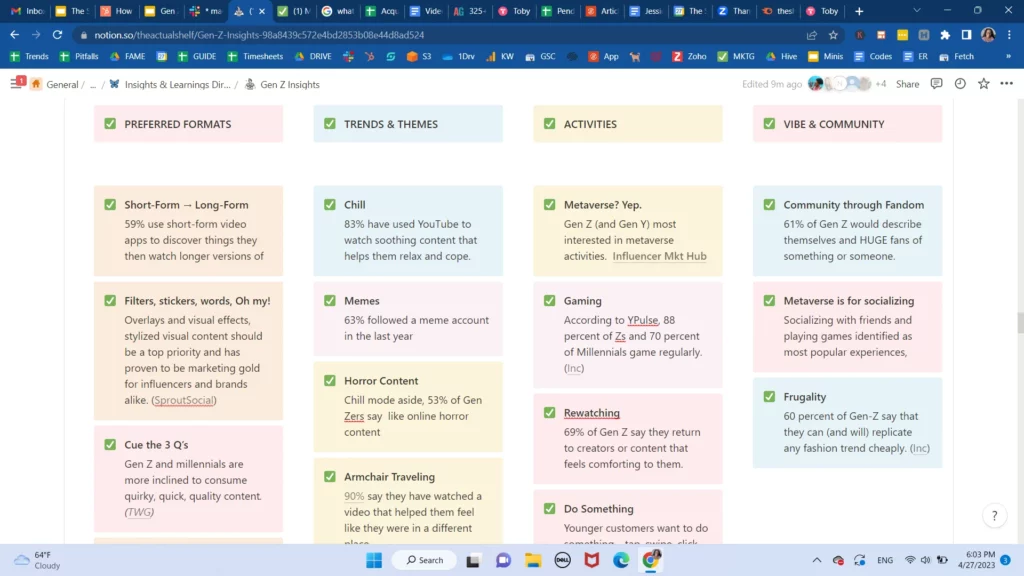
#7 For Gen Zs, Being Distracted Doesn’t Mean DisConnected
Sure, millennials grew up with the internet and desktop computers. But Gen Z grew up with mobile devices and social media, and it shows in their daily habits.
Sixty-six percent of Gen Zers are ultra-distracted because they’re using more than one device at a time. As you’d imagine, they are watching entire seasons of shows On Demand while doing stuff on their and grabbing their smartphones when they ping. And they’re engaging with each device throughout the day (or even by the hour).
Because of all these inter-connected distractions, it’s tough to get, and even tougher to keep, the attention of your average Gen Zer. If you thought millennials’ 12-second attention spans were bad, then you’ll find Generation Z’s 8-second attention span horrifying.
Or is it? As it turns out, Gen Zs may have stumbled across an evolutionary moment for humans that previous generations can’t really grok. According to a Kantar study commissioned by Snapchat, Gen Zers display higher advertiser recall than older social media users even when they’ve spent less time actually watching an ad.
Less than two seconds. That’s what the average Gen Z consumer needs to see and remember an ad AND the advertiser. For foggy minds like mine whose system for remembering things includes paper and digital planners and existing in a perpetual state of having 33 tabs open on my laptop AND my desktop (because I am legit working on both right now)… this is unfathomable.
I literally can’t with this.
Gen Alpha has yet to show up on the scene and really move the evolutionary needle for humanity, but Gen Z has mastered the concept of distracted but not disconnected:
- 94% own laptop computers
- 80% receive most information from social media
- 75% say smartphones are their top choice
- 75% spend their free time online
- 73% follow at least 1 brand on a social
- 25% spend five hours A DAY on their phones
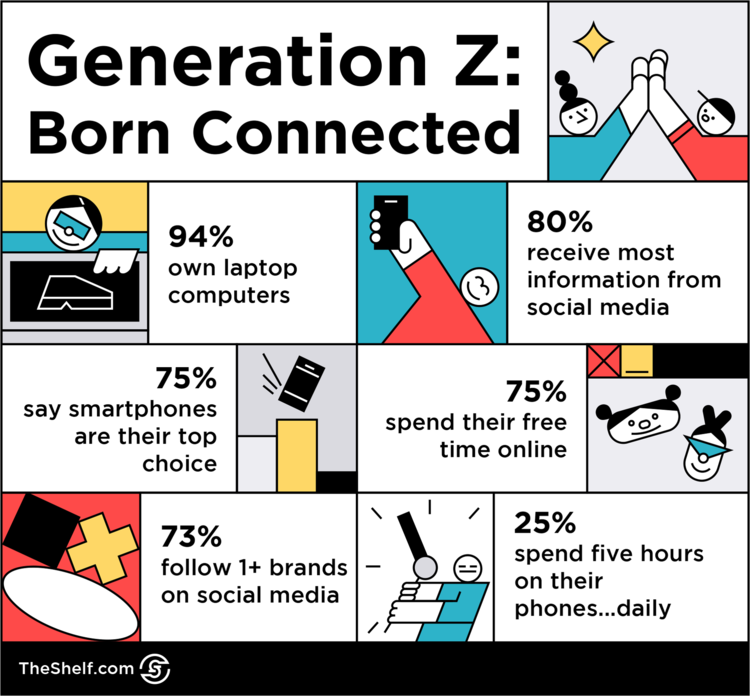
COPY AND PASTE THIS CODE TO EMBED ON YOUR SITE
It seems as though they spend the majority of their lives on a device. As a brand, you can capitalize on this by ensuring your campaigns are responsive.
50% of Gen Z consumers are more likely to buy from brands that demonstrate they really understand their wants and needs.
And 41 percent say they would buy from a brand that delivers timely, responsive customer service over a competitor, according to SproutSocial.
Being mobile-friendly isn’t enough. Your ads, blog posts, videos, and other marketing materials need to be accessible and easy to engage with on any platform.
To that point, make sure your content is interesting, visually-appealing, and engaging. Eighty-five percent of Gen Zers say easy mobile experiences are a top priority for making a purchase. In other words, if it won’t work on mobile, then you’ve lost a potential customer.
#8 Gen Z’s Shopping Journey Begins & Ends In the Store
Here’s an interesting catch though, and it’s a BIG one:
Despite the virtual tendencies of this digital-native generation, guess where they are going for reprieve? Good ol’ brick and mortar stores. If your response was “what the what” that’s okay.
We’ve got intel. As of September 2019:
81 percent of Gen Zers prefer shopping in-store.
73 percent like to discover new products in store.
While this generation is immersed in all things digital, they are seeking refuge in the physical. So, thought needs to go into aligning your in-store experiences with your digital campaigns, too.
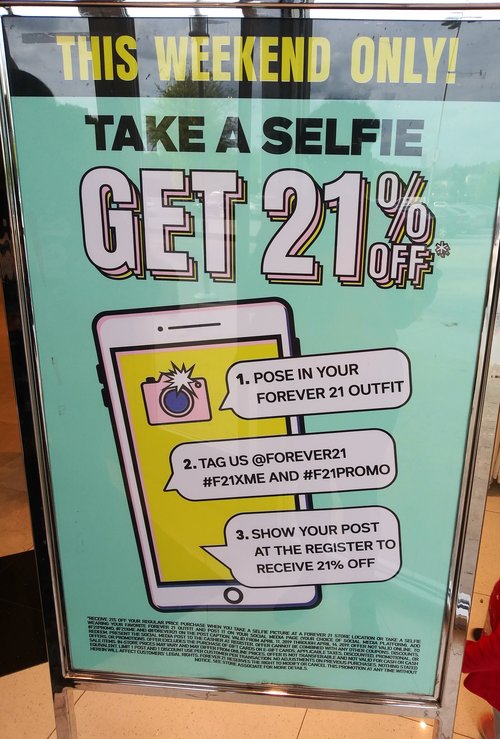
Gen Z discovering brands and products through social search
Generation Z isn’t using Google to search around for products to buy. Instead, they’re exposed to products on Instagram and they search for everything from local restaurants to local events on TikTok. Weren’t you shocked last summer when the stat that 40 percent of Gen Zers use TikTok and IG for search starting floating around?
That stat’s a little misleading, as I discovered when I walked that info back a bit. The original story published by TechCrunch was around Gen Z bypassing Google for TikTok, not TikTok bypassing Google as a search engine.
Still, it was startling… but kinda believable, right?
Young shoppers are finding and being shown new products in their social feeds. So, what happens once they discover a product? The next step is to head on over to YouTube to see it up close and personal, while also getting an honest review from a YouTuber they trust. They’ll likely look at multiple videos to get a holistic view of a product or service before making a decision.
So quite literally, their experiences with your product in the physical world will often be seeded from a digital or virtual experience. Best advice, short and sweet: Build a social media marketing strategy that includes working with non-celebrity influencers that threads opportunities to reach them with personalized content on their phones through SMS, gated communities, or paid social.
Wrapping Things Up
In the beginning, marketers thought Gen Z would be an extension of millennials. They grew up in a similar technologically advanced world, so it only made sense that they would follow suit.
But as we look closer, we can see the lines drawn between millennials and Generation Z, especially in the way they shop. Post-millennials are more inclined to purchase in stores, care more about cool products than cool experiences, and are prominent in speaking and acting on important matters.
Brands that stand for something, offer seamless online/offline experiences, and are obligated to providing quality products at competitive prices are going to come out on top. Because remember, Gen Z will make up nearly half of the consumer market in less than a year.
So if you haven’t already future-proofed your campaigns, it’s time to start!


